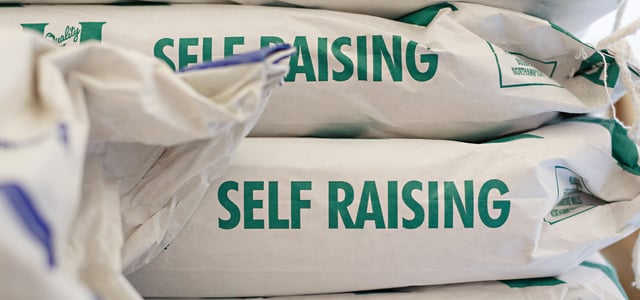Have you ever thought what is the difference between plain flour and self-raising flour?
As flour is an integral part of the baking process, we think it is very important to get right.
Plain flour, also known as all-purpose flour, has about 75% of the wheat grain, with most of the bran and wheat germ taken out. Commonly used for cakes, pastries and biscuits. This can also be accompanied with a rising agent, like baking powder and bicarbonate of soda to help with the rising process.
Self-raising flour however has a rising agent, and can contain salt, which has already been added. Whereas the plain requires these rising agents to added separately to make the cakes rise.
So, can you switch plain flour for self-raising flour within a recipe?
Unfortunately, you should not really switch the two, as it is important to remember that these two different ingredients are not interchangeable and you should use the flour the recipe states.
How much raising agent is actually in self-raising flour?
As self-raising flour is still just plain flour which had had the rising agents added to it, the amount of rising agent is the same as half a teaspoon of baking powder per 100g of plain flour.
We use self-raising flour within our cake just to ensure that each cake mix contains the perfect mix of flour and rising agents. To make sure that all Sponges rise perfectly! Our self-raising wheat flour contains sodium bicarbonate in order for the Sponges to rise!
We need all our sponges to contain the same quantity of rising agents, for them to rise the right amount. This is why we use self-raising flour that already has the rising agents within the flour, for it to remain consistent.
Gluten Free Flours
To make our extraordinary Gluten Free Sponge Cakes we use special Gluten Free Self-raising flour, which is made out of rice, potato, tapioca, maize and buckwheat. For our Gluten Free Sponges, we use self-raising flour as well to ensure that they rise as well as our regular sponges.
We use high quality self-raising flour within all of our cakes to ensure they cook to our high standards. As well as all British ingredients, and supporting other British companies.
As for our Vegan Sponges we use the same Self raising flour as for our normal sponge cake recipes but using soya the plant based milk.
What’s the difference between flour and corn flour?
All-purpose flour (or plain flour) has a slightly finer texture than corn flour. Corn flour can be coarser, and it behaves differently than all-purpose flour, as it is more absorbent. You can use corn flour in baking (it could be a great alternative for a gluten free bake, as it’s naturally gluten-free), but you need to approach it with some knowledge about how it works. You’ll need to increase the amount of liquid in a recipe, such as milk or water, to compensate for the absorbency. This will help reduce the risk that your baked item will be dry or dense.
Another pro for cornflour is that it’s lighter and sweeter, so it provides a different flavour profile and texture to all-purpose flour. So, it could be one to consider when you’re looking for an alternative flour.
What’s the difference between cornstarch and corn flour?
So, let’s start with the obvious, most people don’t really know the difference between the two because they both do derive from corn. The key differences are in their nutrient profiles and uses. Cornstarch (as in its name) is a ‘starchy’ gluten free flour, whereas corn flour is a ‘protein’ gluten free flour.
Typically, cornstarch is a very fine white powder, that has a chalky appearance, and is more often used as a thickening agent to thicken sauces like roux’s and custard. It’s obtained by extracting the starch from the endosperm of the corn kernel.
Corn flour, however, is made using the entirety of dried corn kernels, and they are processed into a fine powder. It contains fibre, protein, and a small amount of fat, as well as the starch. This can be used for a variety of cooking recipes, and as mentioned above can be used as a gluten-free alternative to other standard flours.
Check the date!
Make sure when you are baking yourself at home, that you check the expiration date of the flour which you are using especially when you are using self-raising flour. If your self-raising flour is out of date then your sponge may not rise properly! As it is know that plain flour has a generally longer self-life than self raising flour, due to the fact it does not have rising agents which expire.
We get through so much self-raising flour, there is not an issue with making sure that we use it up in time, therefore we prefer to use self-raising flour.


